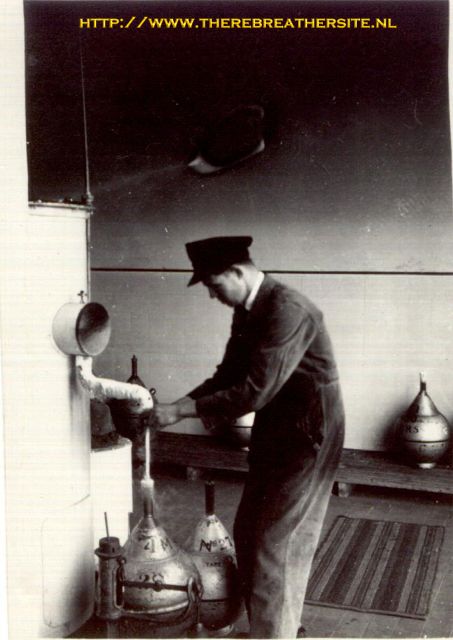|
|
||||||||||||||||||||||||||||||||||||||||||||||||||||||||||||||||||||||||||||||||||||||||||||||||||||||||||||||||||||||||||||||||||||||||
|
|
||||||||||||||||||||||||||||||||||||||||||||||||||||||||||||||||||||||||||||||||||||||||||||||||||||||||||||||||||||||||||||||||||||||||
Mr Wilf Robinson (died in 2013), father of Brian Robinson, filling an oxygen flask
|
||||||||||||||||||||||||||||||||||||||||||||||||||||||||||||||||||||||||||||||||||||||||||||||||||||||||||||||||||||||||||||||||||||||||
|
22-04-2009
I have not seen
mention of the Aerorlox Mk2, I use to work at Siebe Gorman and worked on
this unit plus also admiralty stuff.
It was an upgrade to 6
Hours duration.
Hi Jan
Unfortunately I don't have
much info on the unit, what I can tell you is that there was no difference
externally as we used the same case. The major changes were inside, from
what I can remember (some 30 years ago) was it had a larger cylinder and
from this came a long thin coil, it was about 50+ turns and approx 100mm
diameter, this was a new approach to stop liquid oxygen getting though to
the user and to save space the cylinder went through the middle of the coil
enabling the use of a larger one, so the time span was increased from 2 to 6
hours.
I'm afraid this is all I
can remember.
I can tell you a little
story regarding this unit and the USA.
This unit was for deep mine
rescue for the the likes of Canada, South Africa, Australia etc, now the US
BofM (which used to be the abbreviation for the US Board of Mines) would not
let this unit be used in the USA as there was no audible warning as to when
the cylinder was running out.
There was a major disaster
in one of the mines in the USA (it was in the 70's, can't remember where)
now the problem was well deep and it was going to take approx 2 hours to get
to the incident !!!.This Mk2 was the only unit that could do it, the owner
of the mine went against the US BofM and contacted a mine in Canada asking
if they could lend them some units, they could only let them have a few as
they obviously needed to keep some incase they had a problem and suggested
they contact Siebe Gorman to see if they could help.
Now at the time I was
working in the tool room and we had our managing director come into the tool
room with staff of the light assembly department and explained the situation
to us.
We could help, as we had
40+units assembled and ready to go out, the problem was that we had no
bottles for these units, USA had plenty, but as usual the USA they had
different bottle theads so we had a mad session doing mods.So, light
assembly were stripping the units down, the bottle valve was brought to me
in the tool room, I was remachining the threads to suit the USA bottles,
from me the valves were taken to the plating shop and then a full circle
back to the light assemble to rebuild and test.
It was quite late at night
when we finished, the police were waiting outside to escort the units to
Heathrow (I think) and off they went.
I can't remember the
outcome with the mine.
After this the US Bof M
allowed the unit to be used.
Just in passing, do you
know what the 2 metal strip that run from top to bottom on the lid are for?
They are not there to give
strength to the case, they are skids, so rescuers don't have to crawl
through small gaps, they could lie on their backs and slide along using the
feet to push them along.
Best regards
Terry |
||||||||||||||||||||||||||||||||||||||||||||||||||||||||||||||||||||||||||||||||||||||||||||||||||||||||||||||||||||||||||||||||||||||||
|
Update aug
2014;
First, the Mk2 was to 3 hours not 6, simply by retesting to that time, it
worked.
Of course it mentions "cylinder", the Aerorlox had liquid oxygen not a
cylinder, so no thread changes,,,,. The mine he mentioned in the US was
Sunshine Silver mine in 1972 where 100 men died. There are photos of teams
using the Aerorlox there
|
||||||||||||||||||||||||||||||||||||||||||||||||||||||||||||||||||||||||||||||||||||||||||||||||||||||||||||||||||||||||||||||||||||||||
|
||||||||||||||||||||||||||||||||||||||||||||||||||||||||||||||||||||||||||||||||||||||||||||||||||||||||||||||||||||||||||||||||||||||||


